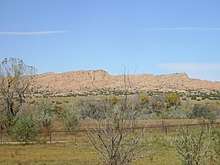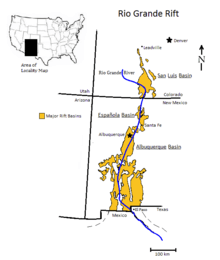Santa Fe Group (geology)
The Santa Fe Group is a group of geologic formations in New Mexico. It contains fossils characteristic of the Oligocene through Pleistocene epochs.
| Santa Fe Group Stratigraphic range: Oligocene to Pleistocene | |
|---|---|
 Los Barrancos, New Mexico, underlain by Santa Fe Group beds | |
| Type | Group |
| Sub-units | See text |
| Overlies | Espinaso Formation |
| Thickness | 5,000 m (16,000 ft) |
| Lithology | |
| Primary | Siltstone |
| Other | Sandstone, conglomerate |
| Location | |
| Country | |
| Extent | Rio Grande rift |
| Type section | |
| Named for | Santa Fe, New Mexico |
| Named by | Hayden |
| Year defined | 1869 |
 | |
Description
The Santa Fe Group is widely defined as basin-filling sedimentary and volcanic rocks of the Rio Grande rift.[1] These range in age from late Oligocene to Pleistocene. The oldest formations in the group correspond to the earliest structural deformation associated with rifting. Geologic uplift of the region around the rift has ended deposition, and erosion in the Rio Grande river system has exposed many of the beds deposited earlier, often spectacularly, as in the badlands north of Santa Fe.[2][3]
The formations in the group are divided into lower and upper sections. The lower Santa Fe Group was deposited in bolsons where streams drained into intermittent playa lakes surrounded by piedmont deposits eroded from basin-margin uplifts. The upper Santa Fe Group was deposited in externally drained basins associated with the ancestral Rio Grande whose drainages flowed toward southern New Mexico. Some geologists also define a middle section transitional between the upper and lower sections.[3]
Formations
Upper Santa Fe Group:
- Ancha Formation[4]
- Palomas Formation[5]
- Puye Formation[4]
- Tuerto Formation[4][6]
- Arroyo Ojito Formation[6]
- Cochiti Formation[6]
- Sierra Ladrones Formation[6]
- Alamosa Formation[7]
Lower Santa Fe Group:
Fossils
G.K. Gilbert visited San Ildefonso Pueblo with the Hayden Survey in 1873 and found fossil mammal bones characteristic of the Pliocene. Some of these were sent to Othniel Marsh. His bitter rival, Edward Drinker Cope, arrived at San Ildefonso the next year and collected a number of Miocene repile, bird, and mammal fossils. [12]
Childs Frick sent an expedition into the Tesuque area in 1924, and immediately recognized the paleontological potential of the Santa Fe beds. The Fricks Laboratory (merged with the Department of Vertebrate Paleontology of the American Museum of Natural History in 1968) carried out field work through 1972. Work prior to 1940 was careless about identifying exact source strata, though greater care was taken thereafter.[13] Most of the fossils came from the Pojoaque Member of the Tesuque Formation and were almost entire found within thin (0.5–3 m) maroon-red to pale green claystone to fine-grained siltstone beds of lithosome B. These are interpreted as small lacustrine deposits.[14]
Fossils found in the Santa Fe Group include the canids Hemicyon and Carpocyon webbi, the antilocaprids Cosoryx, Merycodus, and Ramoceros, chiroptera from the Vespertilionidae and Antrozoinae, the turtle Glyptemys valentinensis, and mastodonts. [15][16]
Economic geology
The groundwater potential of the Santa Fe Group was recognized by Kirk in 1938,[17] and the Alamosa subbasin of the San Luis Valley, the central part of the Albuquerque Basin, and the southern Mesilla basin from Las Cruces to El Paso are now among the most productive groundwater reservoirs in the western United States.[18]
History of investigation
Hayden gave the name "Santa Fe Marls" to the extensive sedimentary beds in the valley of the Rio Grande near Santa Fe during his 1869 survey of New Mexico and Colorado. He likened these to the badlands of South Dakota and correctly determined that they were upper Tertiary in age and were much younger than the Galisteo Formation beds which they overlie. He noted their great thickness, which he observed to be at least 1500 feet (500 m).[19]
By 1936, the Santa Fe Formation had been traced from central New Mexico into southern Colorado.[20] Two years later, Bryan recognized that it extended at least from the San Luis Basin to beyond El Paso and was extensively faulted and deformed. He interpreted the formation as being deposited in a series of basins along an ancestral Rio Grande.[17] The formation was promoted to group status in 1953[21] and defined by Baldwin three years later as basin-filling sedimentary and volcanic rocks of the Rio Grande rift.[1]
Galusha and Blick advocated a much narrower definition of the Santa Fe Group in 1971. They restricted it to the Tesuque Formation and Chamita Formation in the Espanola basin, and specifically excluded the older Abiquiu and Zia Formation and younger Ancha Formation.[22] However, the broad 1956 definition by Baldwin has been widely accepted.[23][24][25][26][27][28]
References
- Baldwin 1956
- Galusha and Blick 1971, p.8
- Connell 2001, p.A-8
- Baldwin 1956, p.119
- Lozinsky and Hawley 1986
- Connel 2001, p.A-15
- Brister and Gries 1994, p.48
- Seager et al. 1971
- Baldwin 1956, pp.118-119
- Connel 2001, p.A-9
- Baldwin 1956, p.118
- Kues et al. 2014
- Galusha and Blick 1971, p.14
- Williamson 2016, p.iv
- Galusha and Blick 1971, p.19
- Williamson 2016
- Kirk 1938
- Hawley and Kernodle 1999, p.1
- Hayden 1869
- Wilmarth 1936
- Kottlowski 1953
- Galusha and Blick 1971
- Hawley and Kernodle 1999
- Connell 2001
- Armstrong et al. 2013
- Brister and Gries 1994
- May and Russel 1994
- Repasch et al. 2017
Bibliography
- Armstrong, Corine; Dutrow, Barbara L.; Henry, Darrell J.; Thompson, Ren A. "Provenance of volcanic clasts from the Santa Fe Group, Culebra graben of the San Luis Basin, Colorado: A guide to tectonic evolution". New Perspectives on Rio Grande Rift Basins: From Tectonics to Groundwater. doi:10.1130/2013.2494(02)}.
- Baldwin, Brewster, 1956, The Santa Fe group of north-central New Mexico, IN Rosenzweig, A., ed., Guidebook of the southeastern Sangre de Cristo Mountains, New Mexico: New Mexico Geological Society Field Conference Guidebook, Oct. 19-21, 1956, no. 7, p. 115-121.
- Brister, Brian S.; Gries, Robbie R. "Tertiary stratigraphy and tectonic development of the Alamosa basin (northern San Luis basin), Rio Grande rift, south central Colorado". Basins of the Rio Grande Rift: Structure, Stratigraphy, and Tectonic Setting. doi:10.1130/SPE291-p39.
- Kirk, Bryan (1938). "Geology and ground-water conditions of the Rio Grande depression in Colorado and New Mexico". The Rio Grande Joint Investigation in the upper Rio Grande basin in Colorado, New Mexico, and Texas. U.S. National Resources Committee. pp. 197–225.
- Connell, Sean D. (2001). "Stratigraphy of the Albuquerque Basin, Rio Grande Rift, Central New Mexico: A progress report". New Mexico Bureau of Mines and Mineral Resoureces Open File Reports. 454B. Retrieved 13 May 2020.
- Galusha, Ted; Blick, John C. (1971). "Stratigraphy of the Santa Fe Group, New Mexico" (PDF). Bulletin of the American Museum of Natural History. 144 (1). Retrieved 13 May 2020.
- Hawley, John; Kernodle, Mike (1999). "Overview of the Hydrogeology and Geohydrology of the Northern Rio Grande Basin - Colorado, New Mexico, and Texas" (PDF). WRRI Conference Proceedings. 44. Retrieved 13 May 2020.
- Hayden, F.V. (1869). United States Geologic Survey of New Mexico and Colorado.
- Kottlowski, F.E. (1953). "Tertiary-Quaternary sediments of the Rio Grande Valley in southern New Mexico" (PDF). New Mexico Geological Society Field Conference Guidebook. 4: 144–148. Retrieved 17 May 2020.
- Kues, Barry S.; Lewis, Claudia J.; Lueth, Virgil W. (2014). A brief history of geological studies in New Mexico : with biographical profiles of notable New Mexico geologists (First ed.). New Mexico Geological Society. ISBN 978-1-58546-011-3.
- Lozinsky, R.P.; Hawley, J.W. (1986). "The Palomas Formation of south-central New Mexico; a formal definition" (PDF). New Mexico Geology. 8 (4): 73–78, 82. Retrieved 14 August 2020.
- May, S. Judson; Russell, Lee R. "Thickness of the syn-rift Santa Fe Group in the Albuquerque Basin and its relation to structural style". Basins of the Rio Grande Rift: Structure, Stratigraphy, and Tectonic Setting. doi:10.1130/SPE291-p113.
- Repasch, Marisa; Karlstrom, Karl; Heizler, Matt; Pecha, Mark (May 2017). "Birth and evolution of the Rio Grande fluvial system in the past 8 Ma: Progressive downward integration and the influence of tectonics, volcanism, and climate". Earth-Science Reviews. 168: 113–164. doi:10.1016/j.earscirev.2017.03.003.
- Seager, W.R.; Hawley, J.W.; Clemons, R.E. (1971). "Geology of San Diego Mountain area, Dona Ana County, New Mexico" (PDF). New Mexico Bureau of Mines and Mineral Resources Bulletin. 97. Retrieved 14 August 2020.
- Williamson, Garrett R. (2016). "The stratigraphic position of fossil vertebrates from the Pojoaque Member of the Tesuque Formation (Middle Miocene, Late Barstovian) near Española, New Mexico". Electronic Theses and Dissertations. 41. Retrieved 25 July 2020.
- Wilmarth, M.G. (1936). "Lexicon of geologic names of the United States (including Alaska)". Geological Survey Bulletin. 896 (1–2): 2396.